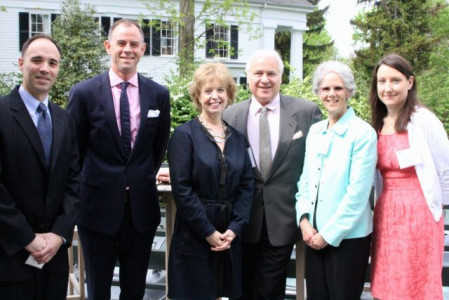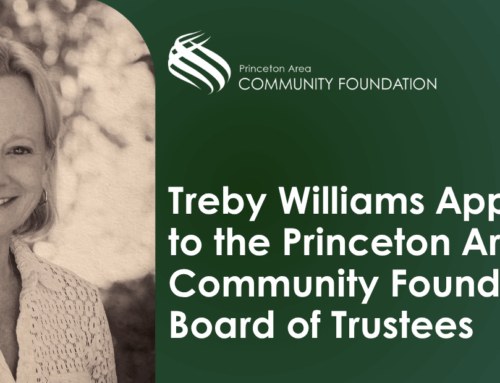The Community Foundation and the Friends of the New Jersey State Museum teamed up recently to host a discussion on how to determine what valuables make good charitable gifts, and to learn about trends in art and collectibles at auction from David Rago of Rago Arts & Auction Center in Lambertville and his colleagues.
When the great New York art dealer Ileana Sonnabend died in 2007, the estate tax return placed her total worth at $876 million, a fortune that included works by the likes of Jeff Koons, Roy Lichtenstein, Andy Warhol and Cy Twombly.

On May 13, the Rago Arts and Auction Center hosted a fascinating talk about how to determine which valuables make good charitable gifts and what’s hot in collectibles and at auction. The event was sponsored by the Community Foundation and the Friends of the New Jersey State Museum.
Pictured, from left, are Anthony Gardner, Director of the New Jersey State Museum; Sebastian Clarke, director of Estate Services at Rago and a specialist in fine furniture and decorative arts; Miriam Tucker, partner-in-charge of Rago’s Estates and Fine Art departments, as well as Estate and Appraisal Services; David Rago of Rago Arts; Nancy Kieling, President of the Community Foundation; and Nicole Jannotte, Executive Director of the Friends of the New Jersey State Museum.
But her estate included an anomaly—to the IRS. It was Robert Rauchenberg’s “Canyon.” The piece received a zero-dollar appraisal by Christie’s, the auction house, because the collage included a feather from a bald eagle, a bird under federal protection. Christie’s determined that the heirs to the Sonnabend fortune would be committing a felony if they attempted to sell it. As a result, the piece could have no market value.
The IRS saw it differently. It appraised “Canyon” at $65 million and stuck the owners with a $29.2 million tax bill.
“The seller would be violating two federal laws and could risk jail time,” said Miriam Tucker, partner-in-charge of the Estates and Fine Art departments at Rago.
The IRS eventually dropped its claim against the Sonnabend estate, but Tucker used the case as an example of the obstacles one can face in the often-rigorous process of appraising, selling or donating high-value collectibles.
Tucker described the “five actors” in the appraisal process: the Donor; the Donee; the Financial Advisor, the Appraiser and the IRS. “When you’re a donor, the best thing you can do is to keep really good written records,” she said. “Keep your receipts or invoices, the name of the creator and the name of the piece. You have to be able to support any donation with written documentation.”
Non-cash charitable contributions valued at less than $5,000 require the donor to submit an IRS Form 8283. Higher priced items, Tucker said, require much more information about the donated property.
Donors must also choose a donee best fitting IRS guidelines to maximize the donation for tax purposes. That starts, Tucker said, with donating to a public and qualified charity. “Any organization you’re donating to will be able to show you their exemption letter, and that’s very important.”

Miriam Tucker, partner-in-charge of Rago’s Estates and Fine Art departments, as well as Estate and Appraisal Services.
To maximize the tax deduction, the donor must ensure the donee’s use of the art is related to the purpose of the organization’s exempt purpose. “Whether it’s a piece of art given to a museum, an item given to an educational institution that has similar objects, or a piece of sports memorabilia, the donated object has to be of the type normally retained and exhibited by that charitable organization,” Tucker said, adding that the donee must show that it truly wants the object. “Your appraisal is based on your item’s acceptance. As appraisers, we need a written acceptance or a letter of intent. That’s what tells us the institution wants your gift.”
Tucker said “objectivity is the rule” with appraisals, which must be independent, impartial and objective. “The appraiser’s responsibility is to the object itself and not to the person paying for the appraisal,” Tucker said, adding that an appropriate fair market value assessment and the date and manner of the item’s acquisition are critical to an appraisal’s accuracy.
If there is a piece of artwork included in a tax return that is valued at more than $50,000, the item is reviewed by a special IRS art advisory panel. The panel, which meets twice yearly, comprises prominent art scholars, dealers, curators and auction house specialists. This panel is responsible for assessing the value of the art.
In 2012, the panel investigated 444 works and valued them at $348 billion – an average of $784,000 a piece. Of note—those pieces came from just 43 taxpayers, Tucker said.
“It’s a powerful job and the panel’s decisions are rarely overruled,” Tucker said. “Even though they are volunteers, they are the art tax police.”
Investing in Art
David Rago, founder of the Rago Arts & Auction Center, took the audience on a journey through trends in 20th century art, as well as resale markets. From the arts and crafts furniture of Gustav Stickley, a progenitor of the American Craftsman style, to the more modern styling of woodworker and furniture maker George Nakashima, Rago discussed emerging and waning markets, and when it is the right time to invest in a piece.
“Markets come and markets go,” Rago said. “Things will always fall in and out of favor. Just remember – it’s only a matter of time before they come back.”
Sebastian Clarke, director of Estate Services at Rago, a specialist in fine furniture and decorative arts and a frequent guest on the PBS series Antiques Roadshow, said that many collectibles such as an ornate silver tea set hold their value in their weight, especially if there is not a lot of interest in today’s market.
Clarke noted the collectibles market is directly affected by the real estate market, as people look to shed or accrue home furnishings. “The market is coming back in 2014, but back in 2008, people weren’t buying and selling homes, so decorators and dealers weren’t working as much. It’s all related,” Clarke said.
“We hoped this seminar would inform collectors who might wish to make a charitable gift of art,” said Nancy Kieling, president of the Princeton Area Community Foundation.
“We often hear from donors asking how they can put their non-cash possessions to use in ways that better the greater community. The Community Foundation works to provide prospective donors with good resources and information to make the best decisions possible.”
For more information, visit www.ragoarts.com.








